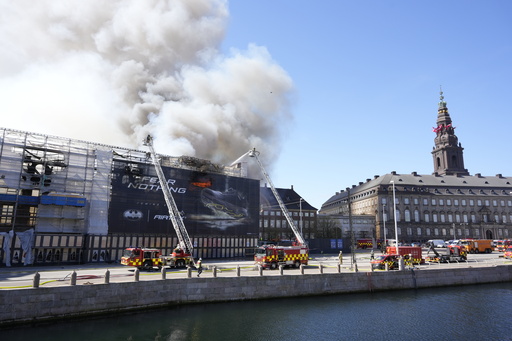COPENHAGEN, Denmark (AP) — Danish firefighters toiled Wednesday to extinguish the last pockets of a fire that gutted Copenhagen’s 400-year-old stock exchange building the previous day, as owners of the structure looked ahead to rebuilding the iconic landmark.
Tuesday’s blaze, which destroyed half of the building and toppled its dragon-tail spire, was believed to have started on the roof during renovations, but the cause remained unclear and police had yet to enter the burned part of the building to investigate.
No injuries were reported despite a hectic scramble in the first hour of the fire to remove valuables, with citizen volunteers helping officials and firefighters in an effort that managed to salvage much of the building’s priceless artwork.
“This is sad, so sad,” 44-year-old civil servant Mikkel Jensen said Wednesday as he looked up at twisted scaffolding still clinging to the ruins of the Old Stock Exchange.
The building, which dates from 1615 and is named the Boersen in Danish, is known for its green copper roof and distinctive 56-meter (184-foot) spire in the shape of four intertwined dragon tails.
Morten Langager, manager of the Danish Chamber of Commerce, which was headquartered in the Old Stock Exchange and owned the building, said it should “rise again.” His boss, chamber head Brian Mikkelsen, said the building will be rebuilt “no matter what” and that the board backed the idea.
The building was undergoing extensive renovations, and there are detailed records of the entire structure’s architecture, including photographs taken just last week of the dragon spire by the National Museum in Copenhagen.
However, no decision has yet been made about who will reconstruct the building, a project which would cost millions, if not billions of kroner (dollars). A cautious estimate said it could take up to 10 years.
Many in Denmark compared Tuesday’s fire to the April 2019 blaze at Notre Dame that destroyed the spire of the 800-year-old cathedral. Its restoration is slated for completion this year.
The extent of the damage, caused by flames and the tons of water poured to extinguish them, was still unknown.
“A lot has disappeared in the fire,” said Tim Ole Simonsen of the Greater Copenhagen Fire Department, which was working to secure remaining outer walls. Up to 40 shipping containers, filled with concrete, will be put around them to stabilize them, the fire department said.
That work will continue through the night. “The work is extensive and requires a large amount of equipment,” the fire department said in a statement.
Police hadn’t yet been able to enter the burned part of the building to begin investigating the cause of the fire, said Brian Belling, a Copenhagen police officer in charge of the investigation.
“It can take a long time to find the cause of a fire,” Belling said.
When the fire engulfed the building on Tuesday, passers-by, Chamber of Commerce staff, police officers and members of an army unit that had been sent to help raced inside the building to save its treasures.
Mikkelsen, who was one of the employees who ran in, told public broadcaster DR that the building had made a plan for what to save in a “worst case” scenario. When it became too dangerous for people to go up to the first floor, firefighters with breathing gear were sent in to retrieve priceless items, he said, adding that many of the building’s most valuable contents, which included irreplaceable paintings and other works of art, had been saved.
Among items saved was the huge 1895 painting “From Copenhagen Stock Exchange” by Danish artist P.S. Krøyer, the Chamber of Commerce said.
About an hour after the first reports of the fire on Tuesday, the blaze engulfed the spire and sent it crashing onto the building, which was shrouded by scaffolding, and onto the street behind.
The fire sent huge billows of smoke over downtown Copenhagen, and many government offices located nearby remained closed Wednesday because of a strong smell of smoke in the buildings. Employees were told to work from home.
The buildings must be cleaned and their ventilation checked before government ministry staff can return, said Rasmus Brandt Lassen, head of the Danish Building and Property Agency.
“We have told them that they should expect to work at home for the rest of the week,” Brandt Lassen said.
The exchange is considered a leading example of the Dutch Renaissance style in Denmark. The Chamber of Commerce moved into the building after Copenhagen’s stock exchange left in 1974.
Its dragon spire was one of the many of topping the city’s churches and castles, which have earned Copenhagen its nickname as “the city of spires.” Other copper-covered belfries include the serpentine spire of Our Savior’s Church, those of the Renaissance Rosenborg Castle downtown, and the tower of the Christiansborg Palace which houses the Danish parliament.
A main road running past the Old Stock Exchange remained closed Wednesday.
This website uses cookies so that we can provide you with the best user experience possible. Cookie information is stored in your browser and performs functions such as recognising you when you return to our website and helping our team to understand which sections of the website you find most interesting and useful.
